

In the Age of Trump, Can Labor Unite?
Donald Trump performed far better among union voters than previous Republican candidates, but since taking office has enacted disastrous anti-worker policies. Now, some unions are organizing their members around an explicitly progressive analysis, hoping to unlock the power of workers to help lead the resistance.
April 26, 2017 | May issue
You know you’re getting the short end of the stick as a worker, but you don’t really know why,” says Joe Tarulli, a Staten Island Verizon tech who’s put in 17 years with the company. “They make it seem like these rich people are just lucky they got the right chances, and these poor old working folks, nothing ever goes right for them. No! These corporations are doing it on purpose.”
Last spring, Tarulli and 39,000 Verizon workers were forced out on a 49-day strike to fend off outsourcing and other concessions demanded by the company, even as it raked in billions in profits. Democratic primary candidate Bernie Sanders walked the picket line with them to draw media attention to their battle against corporate greed. But in the general election, Tarulli says many of his coworkers went on to vote for Donald Trump, who spoke to the anger that had motivated them to strike in the first place. “Trump’s a great communicator,” says Tarulli. “For a long time people felt ignored, even by their own unions, because these companies take advantage of them so badly.”
Trump’s win highlighted a rank and file that feels alienated from politics as usual. While most major unions backed Hillary Clinton, 43 percent of voters in union households cast their ballots for Trump. The swing in votes was less a bump for Trump (who outperformed Mitt Romney by 3 points in union households) than a shortfall for Clinton (7 points below Obama in 2012)—and that’s not counting those who simply stayed home.
“I did believe in him trying to get more jobs back to the United States,” says Trump voter Jack Findley of Chattanooga, Tenn. Findley worked for four years on a Volkswagen assembly line, backing the unsuccessful union drive at the plant in 2014 before an injury put him out of commission. He has two kids, ages 4 and 7, and worries as he watches power companies and retailers in his area shut down. “When my kids get old enough, I don’t know where they’re going to be working,” he says.
It’s difficult to fathom that workers who risked their livelihoods to take on a corporate behemoth like Verizon, or back a long-shot union campaign at Volkswagen, went on to vote for a poster child of corporate greed. But after decades of bipartisan fervor for privatization, budget cuts and so-called free trade deals, many workers are disillusioned with both parties.
“Let’s be honest—one party is directly against us, and one party helps us every now and then,” says Scott Hoffman, president of the American Postal Workers Union (APWU) Boston Metro Area Local. “I think so many union members, and union leadership for that matter, strayed this time because they felt that when they did put people in, the effort didn’t come back.”
From the outset of election season, labor should have been better in touch with this sentiment than anyone; its members were canaries in the coal mines that Trump has sworn to reopen. In January 2016, for example, the group Working America warned that the candidate’s fiery denunciations of free-trade agreements were winning over white union members in the Rust Belt. Yet just a handful of national unions—including APWU, the Communication Workers of America (CWA) and National Nurses United—were willing to throw in their lots with Sanders’ campaign, which channeled the anger and despair of working people toward the real culprit, corporate America.
The lesson of 2016 is clear for labor: Working-class people are angry at the degree of American inequality, desperate for an explanation of how we got here and ready to take drastic action, if presented to them. Whether they opt for Trump and Steve Bannon’s racism or take to the streets against the 1% depends largely on how unions decide to fight back.
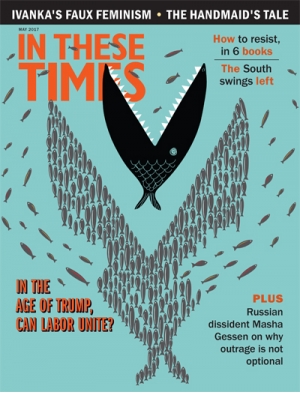
FROM THE MAY 2017 ISSUE
Subscribe and receive this as your first issue,
or
purchase an individual copy.
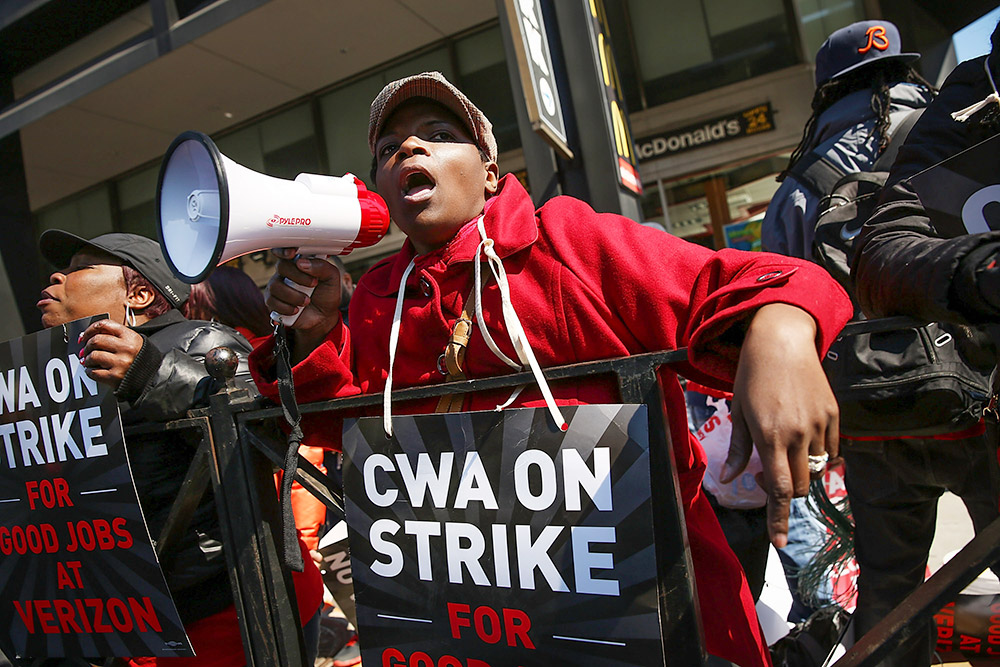
Striking Verizon workers rally outside of the company’s Brooklyn offices on April 13, 2016. (Photo: Spencer Platt/Getty Images)
Part army, part town hall
That fight will also be a battle for labor’s very survival. Trump has already put into place an anti-union cabinet and launched attacks on immigrant workers. Equally hostile appointments to the National Labor Relations Board are sure to follow, along with cuts to the offices that enforce workplace rights, slashes to public budgets and the continued spread of so-called right-to-work laws aimed at wiping out labor’s remaining strength.
In the face of these threats, labor should be the anchor of the resistance to Trump’s policies. Even at the present low ebb, unions represent more than one in 10 U.S. workers—a potential army of 14.6 million people networked together in workplaces across the country, including at key nodes of the economy like warehouses and ports where the prospect of strikes keeps CEOs up at night. Along with raw numbers, unions have decades of organizing know-how and the ability to bring together large numbers of workers across lines of race, gender, nationality and immigration status.
Yet at the moment, most of labor’s forces lie dormant—or worse. Some unions are opting to cozy up to the president’s anti-free trade rhetoric while willfully ignoring his attacks on working people. Several construction and building trades unions jumped at the chance to meet with Trump after his inauguration and seem not to mind his border wall so long as they’re the ones who get to build it. When AFL-CIO President Richard Trumka appeared on Fox News on February 28 to react to Trump’s first speech to Congress, he emphasized points of agreement on trade and, alarmingly, immigration. “This is the first time you heard the president talk about legal immigration being used to drive down wages. We’ve been saying that for a long time,” the nation’s top labor leader said. “Will we partner with him to try to rewrite the immigration rules of the country? Absolutely.”
How can labor live up to its potential to stand for all workers? The labor and antiwar activist A.J. Muste memorably described a union as part army, part town meeting. That dual character gets to the heart of the argument we’ve been making since 1979 at Labor Notes, the magazine and organizing project where I work—that a revived labor movement must be a democratic labor movement, because a union is only as powerful as the action its members are ready to take in unison.
Most unions haven’t bothered to build this kind of member buy-in in decades; inspiration is to be found in the exceptions. Scratch the surface of many of labor’s notable recent fights, and you’ll find rank and filers who first had to wage battles against their own complacent union leadership.
Under the threat of right-to-work laws, which give disaffected members the chance to jump ship, top-down unionism is no longer an option. To survive a Trump presidency, unions will have to gear up to convince their members—many of whom voted for him—to unite and fight the president’s corporate agenda.
Two outlets for anger
For a glimpse of how unions can mobilize disaffected members around a bold vision, look no further than another tight election last fall. In the Teamsters union, members angry at contract concessions and pension cuts nearly toppled the incumbent administration. Teamsters United, a reform slate led by Kentucky Local 89 President Fred Zuckerman, won six executive board seats and the majority of the U.S. vote. Only after Canada’s votes were counted did James Hoffa Jr.—the son of the more famous Hoffa—manage to hang onto the presidency.
Teamsters United was buoyed by strong support in the Midwest and the South, Trump’s strongholds. Both campaigns tapped into an “anti-incumbent” sentiment, says UPS delivery driver Nick Perry, a leading activist in Ohio’s Teamsters United campaign.
Perry’s local in Columbus went overwhelmingly for Teamsters United, 1,044 to 38—and he says most of the drivers he works with voted for Trump, too. One of them was Chris Grant, a former union steward who has worked at UPS for 31 years. “I, for one, was getting tired of the typical politicians in Washington, D.C., and was looking for a change,” Grant says.
In both elections, “there was a lot of uneasiness about people’s jobs,” Perry said. “People were looking for an outlet for their anger.” But Zuckerman and Trump mobilized that anger to different ends. To lots of Rust Belt workers, the presidential choices looked like the same old, same old versus the billionaire who would fight for the little guy. The Teamsters United campaign, on the other hand, reached those voters with a message of solidarity in the face of corporate greed.
Willie Hardy is a retired truck driver in Memphis and an organizer for the longtime internal democracy movement Teamsters for a Democratic Union (TDU), which backed Zuckerman’s slate. That means Hardy, an African-American minister and a Sanders supporter, works closely with plenty of white Trump supporters.
“One thing that unites us is the pension thing,” Hardy says. “You’ve got people that worked all their lives to have a nest egg.” Remarkably, last spring, 207,000 Teamsters and retirees in the Central States Pension Fund won a reprieve when the Treasury Department halted benefit cuts of as much as 70 percent. Thousands of activists scored that first-step victory by rallying, writing letters and packing hearings—all self-organized, with help from TDU and the nonprofit Pension Rights Center. The pension activists are now pushing Congress for a solution to underfunding while Teamsters United activists campaign for a better contract at UPS.
Both Perry and Hardy see Trump voters around them losing faith in the president already, now that they see where he stands on healthcare and right to work. As these shifts happen, activists are in a position to gently influence their coworkers’ thinking. “I look for those kind of moments,” Perry says.
Teamsters United’s near-win is proof positive that even deep in Trump country, an economic populist message can unite a multiracial coalition of working-class voters. But unions must be willing to put that message forward and bring members along.
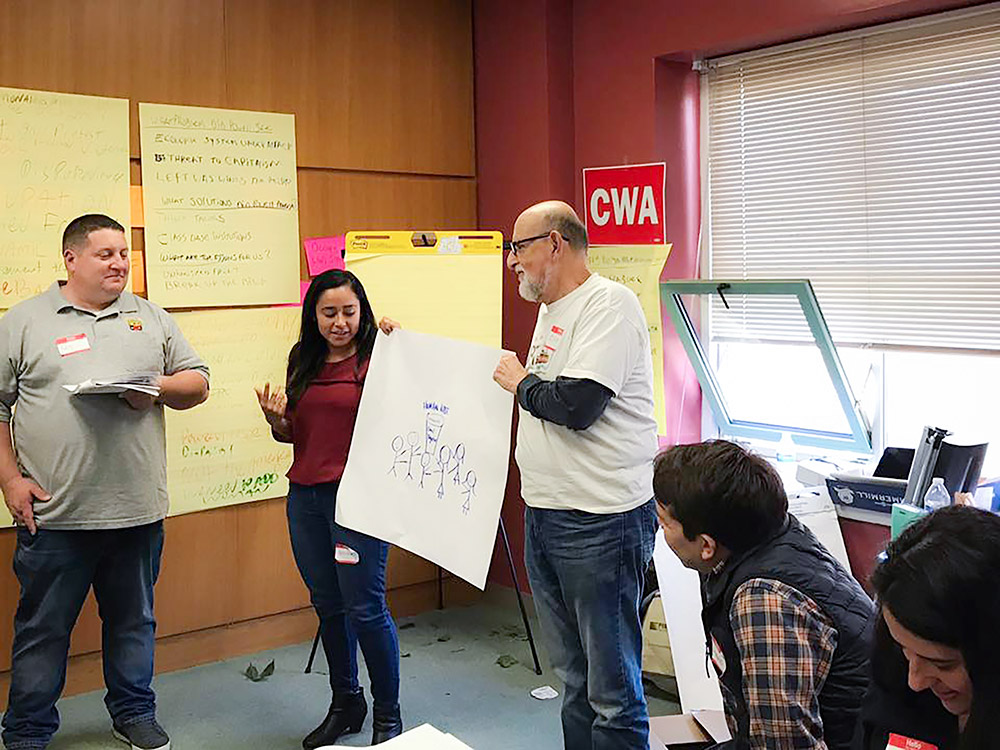
CWA members lead “Runaway Inequality” workshops in Staten Island, N.Y. (Photo courtesy of the CWA)
Light bulb moments
A CWA pilot program offers one of the most promising examples of unions building such a populist vision. The program kicked off in 2015, well before the election, when labor educator Les Leopold, author of Runaway Inequality: An Activist’s Guide to Economic Justice, led a workshop for New York members on how Wall Street hurts workers. For instance, corporate raiders may buy a company with borrowed money, inflate its stock prices to extract short-term profits, then pay off the loan by raiding the pension fund and outsourcing production, leaving the company in ruins.
For Joe Tarulli, the training felt like finally getting a mysterious illness diagnosed. “You’re walking around not feeling good,” he says. “You know there’s something wrong, but you can’t pinpoint it, so you go to the doctor and he does a test and he explains to you what’s going on and you say, ‘Oh, that’s what’s going wrong.’
“It kind of opens your eyes. You can’t start getting better until you know what sickness you have.”
Members liked the workshop so much they started clamoring to bring it to their coworkers—but wanted to conduct the training themselves. So CWA District 1 got funds from the national union to train 60 “Runaway Inequality” member-trainers in 11 states. They’re on track this spring to surpass their goal of presenting the daylong workshops to 1,000 members.
In one exercise, members guess the ratio of a top CEO’s pay to the average worker’s pay—a typical guess is 36 to 1—and discuss what it should be. Trainers point out that a typical Republican thinks the right ratio would be 12 to 1, and a typical Democrat thinks 5 to 1. (The real ratio, according to Leopold, is 844 to 1.
Besides economics, the trainings deal with racism, the prison system and the history of U.S. social movements, with an emphasis on getting out of “silos” to ally with movements besides labor. Some sessions include community participants, and one goal is to feed new activists into local coalitions like Sustainable Staten Island, which includes unions of nurses and university staff, an immigrant rights group, a peace group and an anti-police brutality group.
CWA District 1 Deputy Director Margarita Hernandez recalls that at a workshop in Boston, a white member objected to linking racism with incarceration. “My cousin was in prison, and he’s had a hard time finding a job,” he said. “This impacts everyone.” The member-trainer respectfully asked him to hold that thought. The training covers racial divides in poverty and wealth—for instance, participants discuss a startling graph showing that, on average, a Black college graduate still has only half the household wealth of a white high school dropout. At the end, the man raised his hand again. “You know what? Actually I see what you mean,” he said. “It’s different for a Black person.” Hernandez calls it a “light bulb moment.”
Another program with a similar vision is in the Twin Cities, where groups in the coalition Minnesotans for a Fair Economy have held trainings on economic and racial inequality with members who include janitors, teachers, bank workers, and members of faith and community groups. In one exercise, members use string to map the connections between elected officials and executives of the “Dirty Dozen” most influential Minnesota-based corporations, including Target, Best Buy and General Mills.
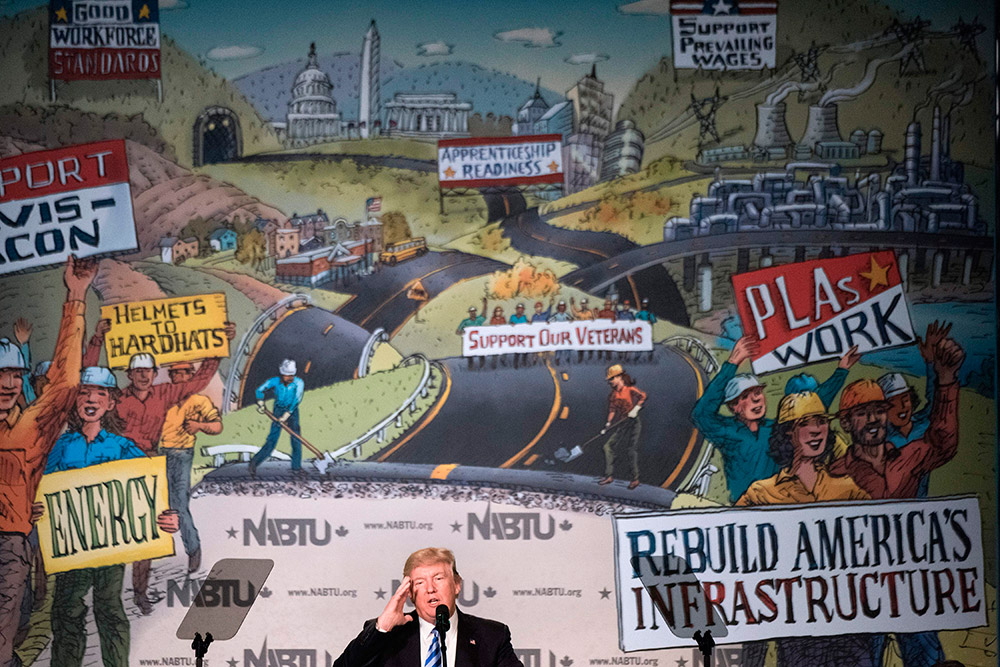
President Trump speaks during the 2017 North America's Building Trades Unions National Legislative Conference in Washington, DC, on April 4. (Photo: Brendan Smialowski/AFP/Getty Images)
Bargaining for racial justice
Unions that have put in the work to educate and mobilize members can become powerful vehicles to confront racism head-on in the era of Trump, in the workplace and beyond. Inspired to support the Black Lives Matter movement, two years ago AFSCME Local 3299—another union led by a rank-and-file reform slate—started internal conversations on racial justice.
Almost half the union’s members—24,000 service and patient care employees at University of California (UC) campuses and hospitals—are Latino, and another 30 percent are other people of color. Even so, the first step was getting members on the same page. Luster Howard, who drives a truck for the UC-run Lawrence Berkeley National Lab, helped organize a series of workshops in which members shared their experiences of racism. He saw the light dawn for some when he told his own story of getting pulled over during his morning commute five times in six months, just for being a Black man driving through a wealthy white neighborhood.
Eventually the union added the topic of immigration to its workshops—and the urgency ramped up once Trump was elected. “A lot of our members were scared,” Howard says. Overt racism in the workplace increased, too. “We’ve heard reports of supervisors saying, ‘I’ll be glad when you guys have to go back to where you came from,” he says.
Two years of these conversations prepared Local 3299 to include racial justice demands in contract negotiations this spring. The union is pushing for a “sanctuary campus” to protect immigrant workers and for UC to counteract the attrition of its Black workforce by hiring and training more workers from disadvantaged groups.
These steps aren’t unique—in fact, Local 3299 based its inclusive hiring proposals on previous wins by unions of city, hotel and hospital workers in California. Sanctuary policies are a common demand among campus workers around the country and especially K-12 teachers, often in alliance with student groups. Other unions have taken up Muslim workers’ rights on the job, bargaining breaks for daily prayers and space to prepare halal lunch. As Trump and company roll back federal protections for workers and members of the public they serve, unions that have laid the groundwork with internal conversations are in a position to push back.
A few unions have already struck explicitly against Trump’s policies, including Inauguration Day strikes by Twin Cities janitors and Boston dining hall workers. And after tens of thousands walked off the job in grassroots Day Without Immigrants actions in February, some unions and worker centers are looking to build on that momentum with strikes on May Day.
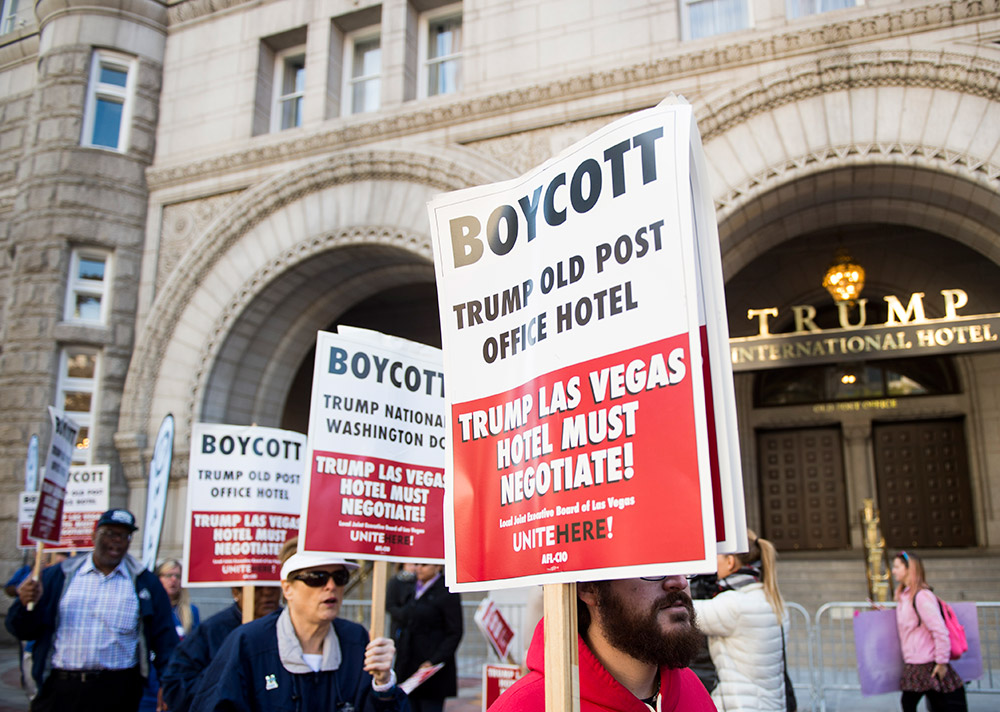
Labor union groups join anti-Trump protesters outside of the Trump International Hotel in Washington, DC, October 26, 2016. (Photo: Bill Clark/CQ Roll Call)
Survival at stake
For any of these campaigns to have a future, however, unions must survive the looming threats they’re facing under GOP control: most significantly, that of nationwide right-to-work laws.
A right-to-work law allows workers covered by a union contract to opt out of paying dues. As of this year, it’s the law for private-sector workers in 28 states, and the danger of a national right-to-work law looms larger than ever. Meanwhile, in the public sector, unions dodged a bullet last year when Justice Antonin Scalia died before the Supreme Court could hear the Friedrichs case, which could have enshrined nationwide right to work—but anti-union groups are already cueing up similar cases.
In Wisconsin, public-sector unions are already living through the worst-case scenario. In 2011, Gov. Scott Walker imposed a draconian anti-union law that goes several steps further than right to work. Not only are public-sector unions open shop, but they must win annual “recertification” votes and have lost almost all their bargaining rights.
Wisconsin provides a troubling forecast of what labor’s future could soon look like nationwide: Union membership there has plummeted from 14.2 percent in 2010 to just 8.1 percent in 2016. But not every union rolled over and gave up. The Milwaukee Teachers’ Education Association (MTEA), representing 4,600 workers, has 69 percent membership among teachers and a slim majority among educational assistants, and those numbers are growing.
Each week, MTEA’s organizing team meets in a “war room” where the wall has been converted to a whiteboard tracking membership activity at each of the district’s 133 schools. Organizers rank them by union strength and develop organizing plans at flagging schools. “It’s a lot of work,” says MTEA Vice President Amy Mizialko, “but I don’t know any other way to do it.”
Has this emphasis on member sign-up drained the oxygen from organizing on workplace issues? Far from it. Last fall, MTEA won a big victory against privatization, halting a legislative scheme that would have accelerated the conversion of public schools to charters. Milwaukee has already lost 44 percent of its public school students to vouchers and charters, so the union teamed up with parent and student groups to fight back—holding walk-ins, deluging legislators with phone calls and holding civil disobedience trainings to prepare members to defend targeted schools. In October, the state announced it wouldn’t be pursuing the takeovers.
From Mizialko’s perspective, MTEA is fighting for the survival of public education in Milwaukee. So she doesn’t mince words when she asks someone to sign a card. “I’ll be direct with people,” she says. “Your students aren’t ever going to ask you to join your union, but they’re counting on you to do it.” In March, MTEA joined student groups to push for a sanctuary school district where immigration enforcement officials are not allowed on school grounds.
One of the largest unions in a right-to-work state is the Culinary Workers Union (UNITE HERE Local 226), which represents 57,000 hotel and casino workers in Las Vegas and Reno. Not only does the union maintain 95 percent membership, it’s a power player in state and national politics. In last fall’s election, “We worked really hard to make Nevada blue,” says Vice President Geoconda Arguello-Kline. Every day, 100 or more rank and filers showed up to volunteer, she says, talking to thousands of voters.
The union’s contracts include family healthcare coverage, successorship language to protect workers’ rights if a company changes hands, and a benefit that’s prized and vanishing among union members: a pension. For years, the union contract has also guaranteed that workers won’t lose their jobs if they have to take time off to clear up their immigration status.
Admittedly, opposing Trump’s anti-immigrant measures is uncontroversial in a union whose members come from 167 countries and speak 40 languages. A majority of members are Latino, and everyone is worried about a friend or family member who’s undocumented.
But the secret the culinary workers and Milwaukee teachers have in common is really no secret at all. Unions that maintain strong membership in right-to-work environments do it the same way any strong union is built: by involving workers in fights on issues they care about, at work and beyond.
Ultimately in order to represent—and remain relevant to—an increasingly diverse class of workers under attack in every area of their lives, unions can’t run from the hard conversations. Instead, activists must do the organizing work it takes to build common ground among their coworkers, and to develop a shared analysis of who our real enemies are and what it takes to fight back. That’s the only way labor can live up to its potential as the army of the resistance—and the only way it can save itself. 
Alexandra Bradbury is the editor of Labor Notes, a magazine and organizing project dedicated to putting the movement back in the labor movement.
Want more news and analysis of the labor movement? Subscribe to the free Working In These Times weekly newsletter:
